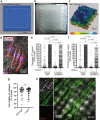An open source extrusion bioprinter based on the E3D motion system and tool changer to enable FRESH and multimaterial bioprinting
- PMID: 34732783
- PMCID: PMC8566469
- DOI: 10.1038/s41598-021-00931-1
An open source extrusion bioprinter based on the E3D motion system and tool changer to enable FRESH and multimaterial bioprinting
Abstract
Bioprinting is increasingly used to create complex tissue constructs for an array of research applications, and there are also increasing efforts to print tissues for transplantation. Bioprinting may also prove valuable in the context of drug screening for personalized medicine for treatment of diseases such as cancer. However, the rapidly expanding bioprinting research field is currently limited by access to bioprinters. To increase the availability of bioprinting technologies we present here an open source extrusion bioprinter based on the E3D motion system and tool changer to enable high-resolution multimaterial bioprinting. As proof of concept, the bioprinter is used to create collagen constructs using freeform reversible embedding of suspended hydrogels (FRESH) methodology, as well as multimaterial constructs composed of distinct sections of laminin and collagen. Data is presented demonstrating that the bioprinted constructs support growth of cells either seeded onto printed constructs or included in the bioink prior to bioprinting. This open source bioprinter is easily adapted for different bioprinting applications, and additional tools can be incorporated to increase the capabilities of the system.
© 2021. The Author(s).
Conflict of interest statement
The authors declare no competing interests.
Figures




References
Publication types
MeSH terms
Substances
Grants and funding
LinkOut - more resources
Full Text Sources
Medical
Research Materials

